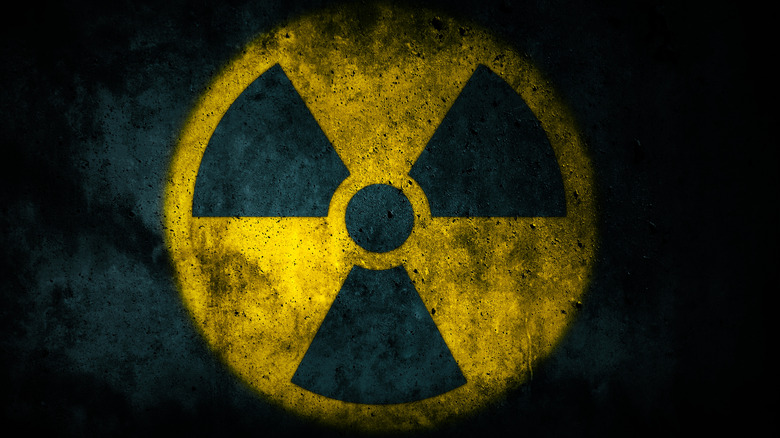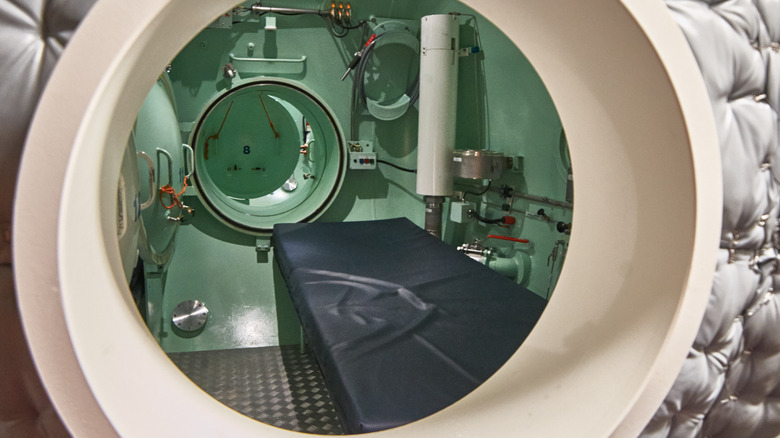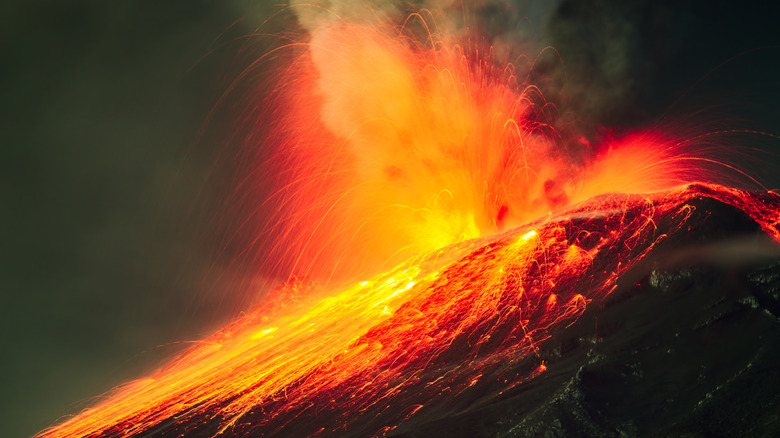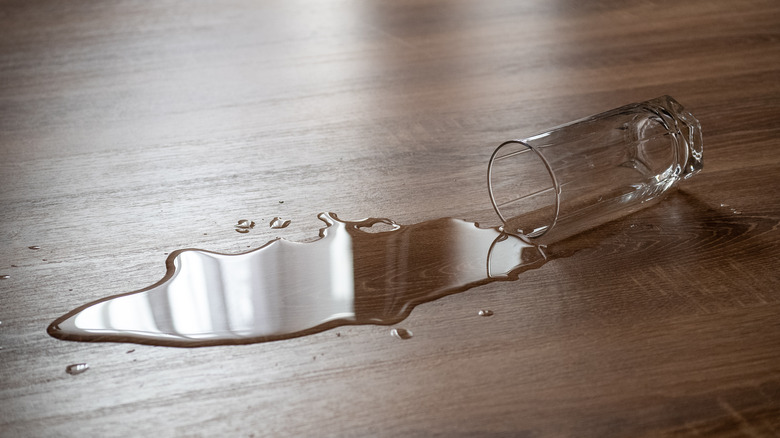The Worst Ways To Die According To Scientists
No one can say for sure what happens after death. The religious tend to cling to the idea of an afterlife of either endless joy or eternal suffering, depending on one's earthly actions. Others say death is just the dissipation of human consciousness into nothingness. Or it might be one of the signs we may be living in a simulation; perhaps after death, we get to start over.
It's this fear of the inevitable that has led many to actively seek immortality. Chinese emperor Qin Shi Huang was reportedly so obsessed with it that he likely died from all the mercury-laced "elixirs of life" he ingested (via Seeker). Interestingly, while humanity has yet to unlock the longevity secrets of jellyfish and lobsters, we have a disturbingly extensive knowledge of how to kill each other. After all, why rely on senescence when there's science and violence, right?
Not all deaths are delivered equal, though. According to scientists — and sadly, recorded history — some mortality methods are simply more terrifying than others, like these 12 existence-enders, for example. Oh, and because it's tough to find irrefutable evidence of how ancient torture methods such as scaphism or the Pear of Anguish were used, this list only features verified ways anyone in this day and age can die.
Being buried alive is absolutely brutal
What's more terrifying than dying? Try being incorrectly pronounced dead ... and then waking up trapped in a coffin 6 feet under the ground. According to Popular Science, the length of time one can survive being buried alive ranges from one and a half days to a paltry 10 minutes, depending on their ability to hold their breath or their body size (a larger individual, for example, would take up more space, leaving less room for oxygen).
If you try to dig your way out, you'd get crushed and suffocated by the sudden rush of dirt and soil. As Colorado Avalanche Information Center director Ethan Greene put it, "It'd be like concrete setting in the course of seconds." Conversely, if you do nothing, the carbon dioxide levels would eventually render you comatose as you gently slip into death's embrace.
FearOf.Net presents an actual term for the irrational fear of this sticky situation: taphophobia. Curiously, this fear led to some chillingly creative coffin "upgrades" in the late 1800s and early 1900s, from breathing tubes and glass panels (via The Guardian) to hey-I'm-still-alive-in-here alarm systems (via Smithsonian Magazine). Think we're past the point where things like this happen? In 2010, the New York Daily News published an article about a 76-year-old beekeeper who would have suffered this fate, had the funeral director not detected his pulse as he lay in his coffin.
Radiation can kill you, sooner or later
No, this isn't about the kind of radiation that cell phones or microwave ovens emit: Non-ionizing radiation isn't strong enough to harm the human body in small doses, according to the FDA. The kind that can really mess you up is ionizing radiation, which you'd get from things like nuclear power plants, weapons tests, or outer space (via Rutgers University).
Ionizing radiation is powerful enough to charge your atoms by removing their electrons (via the WHO). As Popular Science explains, this can seriously damage your DNA, rendering your cells incapable of replicating and triggering their deterioration. The type and degree of suffering you'll endure depends on how you got blasted — whether internally or externally — and how much radiation you got blasted with, among other factors (via the EPA).
We measure radiation exposure in sieverts. The CDC's Radiation Thermometer provides some perspective: A chest X-ray emits about 0.1 millisievert (or 1/10,000th of a sievert), while a flight from New York to Los Angeles emits roughly a third of that. 500 millisieverts can make you nauseated, and 700 millisieverts can cause hair loss within half a month. Meanwhile, 1,000 millisieverts can cause hemorrhaging and diarrhea (via Reuters) while increasing your cancer risk. A dose of 4,000 millisieverts can kill you in two months. 10,000 millisieverts can wreck your intestines and end you in a week, and 20,000 could kill you in mere hours. So yeah, no superpowers for you, only death.
Decompression: a messy way to go
Humans have gotten quite used to living on land. Sadly, we don't fare as well in the air or underwater, partly because of the differences in pressure (since air and water are both fluids). To protect ourselves during travel, we stay inside sealed chambers with consistent pressure. But when pressure abruptly changes due to punctures or damage, uncontrolled decompression happens. Regardless of whether you're flying or diving, it's both ugly and deadly.
According to the Smithsonian Museum, commercial flights reach altitudes of 30,000 to 40,000 feet. Atmospheric pressure gets lower as altitude increases, making your lungs work harder to get oxygen (via National Geographic). To prevent this, a plane's artificial altitude shouldn't exceed 8,000 feet (via TIME Magazine). However, any cracks or punctures during flight could cause decompression. At best, oxygen deprivation could happen. At worst, and with a big enough hole, people can get sucked out of the plane, like in the 1988 Aloha Airlines incident.
Meanwhile, divers experience increased pressure as water pushes down on them. Divers who ascend too quickly can experience decompression sickness: The decreased pressure causes nitrogen and other gases inside their bodies to bubble, leading to unbearable pain, internal damage, mental impairment, and even death.
The most horrific decompression accident is perhaps one that occurred in 1983 in a compression chamber on the Byford Dolphin oil rig. An error resulted in explosive decompression, instantly killing several divers (via The American Journal of Forensic Medicine and Pathology).
Mariana mortality: crushed and consumed by zombie worms
Ever wonder what lies at the bottom of the Mariana Trench? Given how more people have walked on the Moon than explored Earth's deepest oceanic trench (via FlipScience), there aren't a lot of folks who can give a comprehensive answer based on firsthand experience. What experts can tell you with certainty, though, is that this 36,070-foot-deep formation would be an absolutely terrible place to die.
No one in their right mind would dive into the Mariana Trench unprepared and unprotected. Remember, the deeper you dive into the ocean, the greater the pressure. Down there, an unprotected person wouldn't just drown. Every single air-filled cavity in their body would be instantly crushed like paper by roughly 16,000 pounds per square inch of pressure (via National Geographic), and they'll sink instead of floating to the surface. If it's any comfort, though, they'd still be recognizably human since the body's water can't be compressed, as San Francisco Exploratorium physicist Paul Doherty explained in a Reddit AMA thread from 2017.
Then again, what's waiting for the poor victim at the bottom wouldn't really care about that. Meet the Osedax worm, also called the "zombie worm." These mysterious, mouthless invertebrates secrete bone-dissolving acids from their skin, enabling the bacteria living in the worms to consume the nutrients inside the bones of whale carcasses and other corpses. And since they aren't very picky eaters, they probably wouldn't refuse some human hors d'oeuvres.
Free-falling elevators: a rare but horrendous way to die
"Thank goodness for elevators," you think to yourself as you board one on your way up to the 40th floor. Otherwise, you'd have to take the stairs every day. By the time you make it to your office, your legs would probably already be killing you. The smile on your face disappears, though, as the elevator stops just before the 39th floor. Suddenly, your world literally starts crashing down, and you realize what's likely going to happen next: You'll die alone, painfully, at the bottom of an elevator shaft.
There are a number of ways being inside a free-falling elevator could go horribly wrong for you. For starters, you would almost certainly die upon impact, and in the worst way possible. Just ask the "MythBusters" team, who reported that a crash-test dummy ending up in pieces after a nine-story, 53 mph elevator drop. Gravity isn't your only problem here, though. You could just as easily be killed by all the parts and debris knocked loose inside the elevator (via LiveScience). Oh, and your internal organs will likely shift around inside you as you're falling. As Dr. Brad Sagura of the University of Minnesota's Amplatz Children's Hospital explained to CBS Minnesota, the fluid inside your organs, plus the fact that your intestines are "relatively mobile," contributes to how they behave during sudden drops.
Fortunately, today's elevator safety features make it highly unlikely that you'll find yourself in this grisly predicament.
Just stay away from volcanoes, seriously
Deaths directly related to volcanoes will always be extremely unpleasant. You don't even need to be within range of one to verify this: Just read the story of how Mount Vesuvius' unbridled fury wiped out the ancient city of Pompeii.
To satisfy everyone's curiosity, here's what would happen if, say, a researcher observing a volcano from a helicopter accidentally takes what would undoubtedly be the worst dive of their soon-to-end life. According to Universe Today, freshly ejected lava can reach temperatures of up to 2,200 degrees Fahrenheit. By the time the person actually hits the surface of the volcanic pit, they'd be an unconscious fireball. Upon impact with the extremely viscous magma, most of their skeleton would shatter (via INSH). Before long, the person would be ashes. Hiking around a volcanic peak presents a different kind of danger: If the hellishly high temperatures and toxic gases don't kill you, asphyxiation probably will.
Volcanic geysers or hot springs aren't any better. In 2018, LiveScience reported the case of a man who fell into one of the Norris Geyser Basin's pools at Yellowstone National Park. Long story short, the near-boiling, incredibly acidic waters dissolved his remains completely within less than a day. Experts say that he probably didn't feel much, though, as the water would have obliterated his nerve endings within a very short period of time.
Chlorine trifluoride: one nasty customer
In an interview with LiveScience, Paul Doherty, who co-authored a book on different ways to die, talked about one that their publisher found too gruesome to print: getting shot by a Super Soaker full of liquid chlorine trifluoride (ClF3). What he didn't mention was that such a squirt gun would have to be made of specially treated metal (via Discovery); otherwise, it would likely destroy the gunslinger's hand. And if you did shoot someone with it, you would not only kill their nerves but also melt their bones.
Going through the various violent properties of ClF3 makes it clear why Nazis were so interested in weaponizing it during the 1930s. It's incredibly toxic, highly explosive, and insanely reactive, meaning it can set just about anything on fire. In 1965, a man who was exposed to liquid waste containing ClF3 for only around a minute experienced a frontal headache, abdominal pain, and two hours of difficulty breathing, all of which only subsided after he received medical attention.
Experts say that simply sniffing high concentrations of gaseous ClF3 can cause swollen eyes, coughing, breathing trouble, and convulsions. Greater exposure can kill you, but not before you suffer excruciating agony in your eyes, throat, and lungs. Meanwhile, skin contact can cause tissue damage and severe, possibly permanent burns.
Burning can bring unimaginable pain
Frankly, you don't need to fall into a volcano or be exposed to ClF3 to get a firsthand demonstration of extremely hot danger and destruction. On its own, being burned to the point of death is pretty terrible, simply because there are many different ways to get hurt or killed from burning.
When people hear about burns, either first-, second-, or third-degree burns come to mind. These three types affect the skin, with third-degree burns destroying even hair follicles and pain receptors. Here's what many don't realize: That's only halfway through the scale of pyric peril. Fourth-, fifth-, and sixth-degree burns cause serious damage to a victim's fat, muscle, and bone, respectively (via the National Institute of General Medical Sciences). The human body is predominantly water-based and isn't easy to burn (which is why cremation can take up to three hours). Hence, someone being burned to death would actually feel themself burning until they can't feel anything anymore.
Of course, the "fire" part of being set on fire isn't the only thing that can kill a burn victim. Damage to the nervous system, blood loss, dehydration, and even burn infections can all cause death (via Broken Map). If you're trapped with other people in a burning building, inhaling carbon monoxide, hydrogen cyanide, and other toxic components of smoke can be lethal to your tissues — or you could simply suffocate or lose consciousness due to lack of oxygen (via FlipScience).
Crucifixion will make you pray for death
History's most famous crucifixion victim is, without a doubt, that of Jesus Christ. Even non-Christians know that the religious figure died via this ancient form of capital punishment. The "how" part gets left out of the narrative, though, for understandable reasons: The science behind crucifixion isn't for the squeamish.
As physiologist Jeremy Ward told The Guardian, different factors could explain how death by crucifixion happens — and having nails as long as bananas driven through the victim's wrists and feet is the least of them. Once the cross is upright, the victim would have to bear their weight on their bent legs (or arms, if their executioner broke their legs beforehand). Eventually, gravity would win, dislocating the victim's shoulders and stretching them out of their sockets. At this point, the victim's chest would have to do all the heavy lifting, literally. And if suffocation due to a "perpetual state of inhalation" doesn't do them in, multiple organ failure would be more than happy to finish the job. A 2006 paper listed other possible causes, including heart failure, blood loss, and just straight-up losing the will to live.
A person nailed to a cross wouldn't live longer than a day, though someone tied to a cross might last for a few days. For more severe crimes (or extra sadistic executioners), victims were crucified with their arms straight above their heads, cutting their survival time to just 30 minutes, tops.
Capital punishment: Not so clean and painless
Considering the barbaric nature of execution methods from ancient times, you might be feeling relieved at the fact that they're no longer being practiced and that there are more humane ways of delivering the death sentence now. As it turns out, however, the methods of capital punishment used today aren't always as swift, effective, and merciful as they're purported to be.
Take the electric chair, for example. In theory, electrocution should be a quick and painless form of execution. According to ABC Science, it was popular with ordinary citizens in the late 1800s because it seemed like a less cruel alternative to hanging. Unfortunately, it doesn't always work how it should in real life. LiveScience recalled how convicted murderer William Kemmler became the first criminal to die by electrocution in 1890. It actually took two massive electrical jolts to kill him, with journalists reportedly writing about how Kemmler's dead body was "charred and smoking."
And then there's lethal injection, a method that uses three drugs to sedate, paralyze, and cause cardiac failure in inmates sentenced to death. Sadly, researchers who examined post-lethal injection autopsy reports saw evidence that more than 75% of inmates were experiencing pulmonary edema (fluid in the lungs) and left "gasping for air" as they were executed (via NPR). In other words, the first injection didn't always work — and the inmates actually died slow, agonizing deaths. In some cases, the sentence couldn't even be carried out because the executioners couldn't find usable veins on inmates' arms to inject the drugs into.
Dehydration: the dry facts
Given how humans are nearly three quarters water, it's not surprising that the dangers of dehydration can quickly escalate all the way to death.
Popular Science breaks down the journey from dehydration to death into four stages. It starts with thirst. Under extreme heat or fatigue, the body can lose up to 2% of its weight in water through sweating. Without fluid replenishment, bodily systems will start to go haywire as the person's blood volume drops. According to Scientific American, when the person stops sweating, they'll begin overheating. This is the second stage, where the person will start to lose consciousness, and their skin will dry up. At stage three, kidney and liver failure will kick in, seriously damaging organs and poisoning the person from the inside until the final stage (death).
Children are particularly at risk for dehydration-related death, which can come within hours. Meanwhile, a healthy adult can last up to a week with minimal water intake. That's no reason to tempt fate, though, so please get up and grab yourself a glass of water, now.
Decapitation: a potential headache for everyone involved
Decapitation, whether purposeful or accidental, may seem straightforward. The brain controls various bodily systems and functions, and it needs oxygen to do so. Thus, it makes sense that physically separating it from its oxygen supply would shut it down (via The Conversation). That's why beheadings have been around for thousands of years, possibly as far back as the early Holocene epoch (according to a 2015 paper). Sadly, such executions don't always go smoothly, leading to gruesomely uncomfortable situations for both the executioner and the victim.
According to Scientific American, decapitation via bladed weapons occasionally required repeated blows, prolonging the victim's agony by a few minutes and making the whole procedure wince-inducing. This led to the development and adoption of the guillotine in the late 1700s, a mechanism designed to sever the victim's head (and life) swiftly. However, there's rather disturbing evidence that the brain can actually live on for a bit post-decapitation, based on tests involving smaller animals (via Seeker). Consciousness may even continue for up to four seconds.












